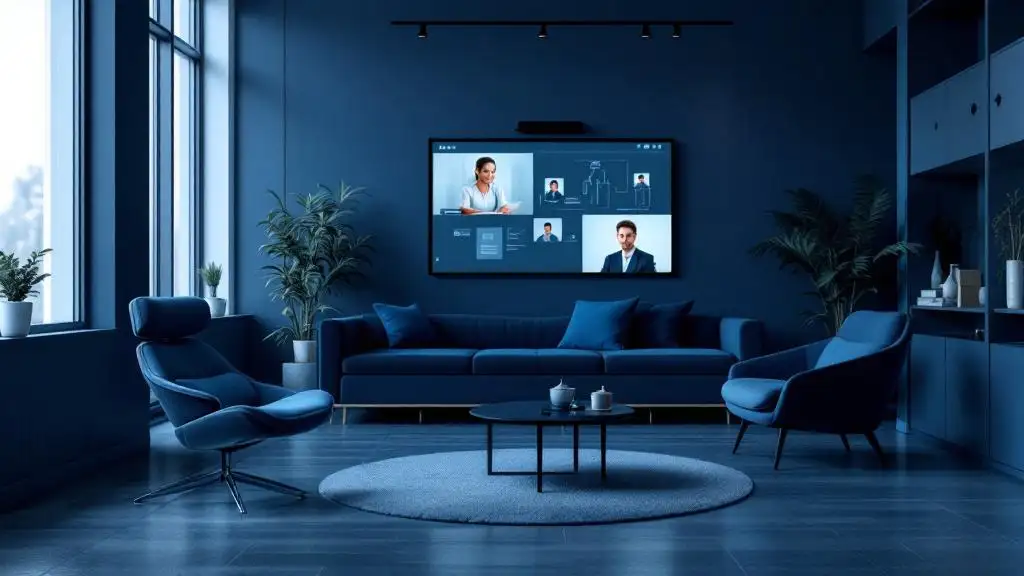Introducing Teletherapy: A Game-Changer for Busy Lives
In today’s fast-paced world, finding time for mental health care can feel overwhelming. Teletherapy offers a practical solution by providing flexible, accessible, and effective therapy options that seamlessly integrate into even the busiest schedules. From early mornings to late nights, teletherapy makes maintaining mental wellness more manageable, ensuring support is always just a click away.
How Teletherapy Fits Into a Hectic Routine
What should I know about scheduling and implementing teletherapy within a hectic routine?
Managing mental health effectively often seems challenging for those with busy schedules. Luckily, teletherapy offers significant flexibility that helps overcome these barriers.
One of the main advantages is the ability to schedule sessions during unconventional times such as early mornings, lunch hours, late evenings, or even weekends. Platforms like Televero Health, Talkspace, and Brightside provide options for flexible hours, allowing you to select slots that best fit your daily commitments.
Utilizing digital scheduling tools like Calendly or TheraNest can streamline appointment management, sending reminders and helping you keep track of upcoming sessions. These tools facilitate quick rescheduling if needed, ensuring therapy remains consistent despite a hectic calendar.
Incorporating brief activities during short breaks can also make a considerable difference. For example, a few minutes of mindfulness, mood tracking, or reviewing therapy notes can reinforce progress between sessions without taking long chunks of time.
Creating a distraction-free environment is crucial. Find a private space, prepare your devices in advance, and minimize interruptions during sessions. This prepares your mind to fully engage with the therapy, making each session more effective.
Most importantly, teletherapy’s format also allows for message-based communication, providing an asynchronous option—perfect for moments when scheduling live sessions isn’t feasible.
Overall, the combination of flexible scheduling, digital management tools, and convenient formats makes incorporating therapy into a busy lifestyle not just possible but straightforward. This sets a foundation for sustained mental health support, even amidst a demanding routine.
Comparing Teletherapy Services for Your Busy Lifestyle

How can I compare different teletherapy services to find what best fits my busy lifestyle?
Choosing the right teletherapy platform involves assessing multiple factors to ensure it aligns with your schedule, preferences, and needs. Start by examining the scheduling options each service offers. Platforms like Talkspace and BetterHelp provide flexible hours, including early mornings, evenings, weekends, and even short sessions that fit into tight schedules.
Next, consider communication channels. Some platforms offer a variety of formats, such as video calls, phone sessions, and messaging-based therapy. Message-based options can be especially convenient for those with unpredictable schedules or who prefer asynchronous communication.
Mobile app availability is another crucial aspect. An easy-to-use app allows for seamless scheduling, reminders, mood tracking, and direct communication with therapists, all from your smartphone or tablet. Checking whether the platform supports switching therapists smoothly and whether it is compatible with your devices can further enhance your experience.
Cost and insurance acceptance are also important. Many services accept insurance or are more affordable than traditional in-person therapy, reducing financial barriers. Verify if the platform provides transparent pricing and if it fits within your budget.
Finally, review the quality and reputation of each platform. Look at user reviews, expert evaluations, and scientific research confirming the effectiveness of their therapy approaches. Consider the types of therapy offered—such as cognitive-behavioral therapy, solution-focused brief therapy, or psychodynamic therapy—and choose a service that provides the modalities best suited for your mental health concerns.
By carefully evaluating these aspects, you can select a teletherapy service that integrates smoothly into your busy routine, making mental health support more accessible and manageable.
| Aspect | Options/Features | Additional Details |
|---|---|---|
| Scheduling Flexibility | Early morning, late night, weekend, short sessions | Ensures therapy fits into diverse daily schedules |
| Communication Formats | Video calls, phone sessions, messaging (asynchronous) | Caters to different comfort levels and preferences |
| Mobile App Availability | Apps for scheduling, reminders, mood tracking, messaging | Enhances convenience and engagement |
| Ease of Switching Providers | Simple transition processes integrated into platforms | Important for ongoing comfort and trust |
| Cost and Insurance | Transparent pricing, insurance acceptance, affordability | Reduces financial barriers |
| Therapy Modalities | CBT, DBT, psychodynamic, solution-focused, etc. | Choose the best fit for your mental health concerns |
| User Ratings and Reviews | Satisfaction scores, expert reviews | Offers insights from other users’ experiences |
Focusing on these factors allows you to make an informed decision, ensuring your teletherapy experience supports your busy lifestyle effectively.
Understanding How Teletherapy Works for Professionals

How does teletherapy work and is it suitable for busy professionals?
Teletherapy connects clients with licensed mental health professionals through secure digital platforms, primarily using video calls, phone sessions, or messaging. This mode of delivery provides real-time counseling in a virtual environment, which is especially beneficial for busy professionals with tight schedules.
Many platforms like Talkspace, Brightside, and others offer flexible hours, including early mornings, evenings, and weekends. Professionals can select times that fit around work commitments, travel, or personal responsibilities. This flexibility ensures therapy seamlessly integrates into their demanding routines.
The quality of care in teletherapy is comparable to traditional in-person sessions. Research shows that virtual therapy effectively treats conditions such as depression, anxiety, PTSD, and OCD through evidence-based methods like cognitive-behavioral therapy (CBT) and acceptance and commitment therapy (ACT). High standards for licensing, confidentiality, and platform security protect patient information, making online therapy both safe and reliable.
One of the major advantages for professionals is the ability to attend therapy from any location—be it at home, in the office, or while traveling. Teletherapy eliminates commuting time and reduces scheduling conflicts, which often pose barriers to seeking help. It also offers enhanced privacy and comfort, allowing clients to speak openly about sensitive issues without concerns about stigma or being seen in a waiting room.
Moreover, teletherapy is compatible with remote work scenarios and travel. Whether during business trips or working from home, professionals can maintain continuous mental health support without interruption. Digital tools like mood tracking apps, appointment reminders, and journaling functions help integrate therapy into daily routines effectively.
In summary, teletherapy is a practical, accessible, and efficient choice for busy professionals seeking mental health support. Its convenience, comparable quality, and adaptability make it an excellent option for maintaining mental well-being amidst busy lifestyles.
Features of Teletherapy for a Hectic Lifestyle

What features of teletherapy services make them suitable for people with hectic lifestyles?
Teletherapy is designed to accommodate busy schedules by offering several flexible features that make accessing mental health support easier. Many platforms provide options for evening and weekend sessions, allowing individuals to schedule appointments outside traditional office hours. This flexibility ensures therapy fits into even the most demanding routines.
In addition to standard scheduled sessions, teletherapy often includes asynchronous communication methods like messaging or email. These allow clients to send updates or ask questions at their convenience without the need for real-time interaction. Some platforms also support recorded sessions or mood tracking, enabling ongoing engagement with therapeutic tools tailored to individual needs.
Mobile device accessibility is another crucial advantage. Teletherapy services are often compatible with smartphones and tablets, so users can attend sessions from any location—whether at home, at work, or during travel—eliminating the need to commute. This mobility reduces stress related to transportation and saves valuable time.
Privacy and confidentiality are paramount in teletherapy. Secure, encrypted platforms protect personal data and ensure that sessions remain confidential, building trust and encouraging regular participation. For busy individuals concerned about stigma or privacy, the comfort of attending therapy from a private space at their convenience adds an extra layer of reassurance.
Finally, accessibility to a diverse array of providers and therapeutic modalities enhances the appeal of teletherapy. Clients can choose from specialists across the country, fitting specific therapeutic styles like CBT or DBT into their schedules quickly and efficiently.
In summary, the combination of flexible timing, asynchronous tools, mobile access, privacy safeguards, and diverse options makes teletherapy a practical, effective solution for those managing hectic lives.
Benefits of Teletherapy in Enhancing Accessibility and Convenience

What are the benefits of teletherapy in improving mental health access and convenience?
Teletherapy has transformed mental health care by making it more reachable for people regardless of their location. One of its main advantages is the elimination of geographical barriers. Individuals living in remote or underserved areas now have the opportunity to connect with licensed therapists without the need for long-distance travel.
Flexibility in scheduling is another major benefit. Patients can often choose appointment times that fit seamlessly into their busy routines, such as early mornings, lunch breaks, evenings, or weekends. This convenience encourages greater participation and helps maintain regular therapy sessions.
The mode of delivery is diverse, including video calls, phone conversations, and even text-based messaging. This variety allows individuals to select the most comfortable and suitable method, accommodating different needs and preferences. For example, some may prefer visual cues during video sessions, while others might find messaging less intimidating.
Additionally, teletherapy reduces the logistical and transportation burdens associated with traditional in-person visits. It cuts out the need for travel, waiting in clinic waiting rooms, and associated costs, which can be barriers for many people. Consequently, it makes mental health care more affordable and less time-consuming.
This flexibility and accessibility foster increased engagement and treatment adherence. Patients are more likely to attend sessions consistently when they can do so from a private, familiar environment.
Research and practical experiences confirm that teletherapy provides an effective, confidential, and adaptable approach to mental health treatment. It broadens the reach of available services, supporting individuals with diverse backgrounds, lifestyles, and needs.
| Benefits | Description | Additional Details |
|---|---|---|
| Geographic Reach | Connects remote or underserved areas to mental health professionals | Eliminates the need for long-distance travel |
| Scheduling Flexibility | Appointments can fit into various schedules | Includes early mornings, evenings, weekends |
| Delivery Modes | Video, phone, messaging | Caters to user preferences and circumstances |
| Reduced Barriers | Less transportation, lower costs | Minimizes logistical hurdles |
| Engagement & Adherence | Supports consistent treatment | Encourages ongoing participation |
In summary, teletherapy’s innovative delivery methods and flexible scheduling significantly enhance access and convenience, making mental health support more available and easier to incorporate into everyday life.
Online Therapy Options With Flexibility for Limited Time
What online therapy options are available that provide flexibility for individuals with limited time?
Many online therapy services are designed with busy lifestyles in mind, offering scheduling and communication options that fit into tight schedules. Platforms like Talkspace, Teladoc Health, and Brightside provide therapy sessions during evenings and weekends, allowing users to attend sessions outside traditional office hours.
These platforms also offer a variety of ways to communicate with therapists, including live video calls, voice calls, and messaging. This flexibility means clients can choose the method that best suits their time constraints and comfort levels, whether they prefer real-time conversations or asynchronous messaging.
Access to licensed therapists is a core feature of these services, with many offering different therapeutic modalities such as cognitive-behavioral therapy (CBT), dialectical behavior therapy (DBT), and psychodynamic approaches. All sessions are conducted through secure, HIPAA-compliant platforms, ensuring privacy and confidentiality.
Switching providers is typically simple and often available at no extra cost, helping clients find the therapist who best matches their needs and preferences. This ease of changing therapists ensures a tailored experience, fostering more effective treatment.
Overall, the combination of flexible hours, multiple communication options, licensed professionals, and easy provider switching makes online therapy an ideal solution for individuals with demanding schedules or limited availability. These options enable consistent mental health support without compromising daily responsibilities.
The Power of Remote, Automatic, and Message-Based Support
How does teletherapy work and is it suitable for busy professionals?
Teletherapy connects individuals with licensed mental health therapists via digital platforms through video, phone, or chat sessions. This mode of therapy is especially beneficial for busy professionals because it offers flexible scheduling options that can be tailored to demanding routines. Many platforms, like Televero Health, Talkspace, and Brightside, provide communication modes including messaging, which allows users to communicate asynchronously. This means clients can send messages when they have a free moment and receive responses from therapists at convenient times.
Moreover, teletherapy is just as effective as in-person sessions for treating conditions like depression, anxiety, PTSD, and OCD. It often employs evidence-based approaches such as cognitive-behavioral therapy (CBT) and acceptance and commitment therapy (ACT). The platform's convenience enables clients to attend therapy from any location—home, office, or while traveling—offering privacy, comfort, and the freedom to open up more openly.
For professionals, the ability to schedule sessions during early mornings, lunch breaks, evenings, or even weekends means maintaining consistency in their mental health care without disrupting work commitments. Virtual sessions eliminate the need for travel, reduce stress related to commuting, and help manage unpredictable schedules more effectively. Plus, digital tools like mood tracking and guided meditations embedded within these platforms further support ongoing mental health maintenance.
In summary, teletherapy provides a practical, effective, and accessible option for busy professionals seeking mental health support. Its flexible nature aligns well with the demanding routines of today's workforce, ensuring consistent and confidential mental health care without sacrificing productivity or personal commitments.
Creating an Environment for Successful Teletherapy Sessions

What should I know about scheduling and implementing teletherapy within a hectic routine?
Successfully fitting teletherapy into a busy schedule requires smart planning and utilization of available digital tools. Online therapy platforms like Televero Health, Talkspace, and Brightside offer flexible hours, including early mornings, late evenings, or weekends. These options help clients choose times that best fit their busy lives.
Scheduling tools such as Calendly, SimplePractice, and TheraNest simplify the process of setting appointments and sending reminders. By integrating these tools, individuals can manage their sessions more effectively, reducing last-minute stress or missed appointments.
A key strategy is to incorporate short, targeted activities during brief breaks—like mindfulness exercises, mood tracking, or reviewing notes—to maintain progress between sessions. This approach ensures continuous engagement without requiring extensive time commitments.
The removal of commute times is a significant benefit of teletherapy. Whether attending from home, work, or while traveling, choosing times during lunch hours or early mornings can help maintain consistency.
To maximize efficiency, it’s essential to prepare a conducive environment. This includes selecting a private, quiet space free from interruptions and checking technology beforehand to avoid technical difficulties.
Overall, flexible scheduling combined with digital management tools helps busy individuals prioritize mental health while minimizing disruption. Teletherapy’s adaptability—such as message-based communication and after-hours options—makes it easier to develop a sustainable mental health routine amidst a hectic lifestyle.
Seamless Integration for Mental Wellness on a Tight Schedule
Teletherapy offers an innovative, flexible solution for individuals with busy lives, effectively breaking down traditional barriers to mental health care. With features like asynchronous messaging, flexible hours, virtual access from any location, and easy-to-use digital tools, it makes prioritizing mental well-being more accessible than ever. Whether you're attending a session during a lunch break, early morning, or late at night, teletherapy fits into your routine without sacrificing your commitments. As the landscape of mental health support continues to evolve, embracing teletherapy means taking a proactive step toward sustained emotional wellness—even amidst a hectic schedule.
References
- Simple Hacks to Fit Therapy Into Even the Busiest Schedule
- Teletherapy: A Solution for Busy Lives
- Explore Flexible Teletherapy Options at Pacific Health Group
- Online Counseling for Busy Schedules
- 10 Ways Teletherapy Can Benefit You
- Teletherapy — Head First Health — Chicago, IL
- Teletherapy. The Future of Mental Health Services in NYC
- How to Get the Most Out of a Teletherapy Session
























































































.png)